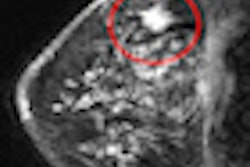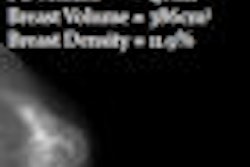To effectively care for women at high risk for breast cancer, screening -- not only the actual imaging, but also interviews with women when they come into the clinic -- must become much more tailored, taking into account individual women's risk factors and using additional imaging modalities if necessary.
That's according to researchers from the University of Virginia (UVA) Health System in Charlottesville. Dr. Jennifer Harvey, head of UVA's breast imaging division, discussed more tailored breast screening in a presentation at the 2009 RSNA meeting in Chicago.
The impetus to tailor medicine got a push when the American Cancer Society published guidelines for using MRI in addition to conventional mammography for women at high risk of breast cancer. And that guidance ushered in a new era, according to Harvey.
"We are in the age of personalized medicine," she said. "And if we're going to talk about more specifically assessing and dealing with breast cancer risk, we need to understand it thoroughly."
Track the genetics
Breast cancer risk factors come in three categories, with varying degrees of risk, Harvey noted: personal risk factors, breast diseases, and genetic propensity.
Personal risk factors such as age at menarche and menopause, obesity, and whether the woman has participated in hormone therapy are associated with average risk, or a less than 15% risk of developing breast cancer in a woman's lifetime.
Moderate risk, or a 15% to 20% lifetime risk, is associated with breast disease such as lobular carcinoma in situ (LCIS), atypical ductal hyperplasia (ADH), or atypical lobular hyperplasia (ALH), dense breast tissue, and prior breast cancer.
And high risk, or a more than 20% lifetime risk, is associated with genetic factors such as being a BRCA1 or BRCA2 carrier, receiving chest radiation at a young age, or a combination of risk factors.
"It's most important to identify women with genetic syndromes," Harvey said. "Mutations in the BRCA1 gene have the strongest association with hereditary breast and ovarian cancer syndrome, and women with this mutation tend not only to develop cancer at a younger age, but also the cancer tends to be triple-negative and much more aggressive."
While personal risk factors can be determined with questionnaires filled out in a patient interview, it can be harder to detect high-risk patients, according to Harvey, especially since clinicians should be looking for genetic propensity from not only the woman's female relatives but also from her male ones.
"If our questionnaire is only about mother, sister, or daughter, we're not going to identify those patients who have paternal histories of, say, pancreatic, breast, or ovarian cancer," Harvey said. "I do a quick-and-dirty screen when I'm talking to a patient, and ask her not only whether she has a family history of breast cancer -- on either side -- but also if any members of her family were young at onset of the cancer, if the cancer was bilateral, and whether she has multiple relatives with cancer. Being of Ashkenazi Jewish ancestry is a risk factor as well. Certainly, if the woman has a history in her family of male breast cancer, that's a huge red flag."
Genetic models can help, although they're not a silver bullet, Harvey said. The National Cancer Institute's Gail model assesses a woman's risk from personal risk factors: The clinician can enter the patient's cancer pedigree, lifetime risk, and whether she's a BRCA carrier. But one of the Gail model's limitations is that it doesn't elicit maternal and paternal information about prior breast disease.
The Tyrer-Cuzick model is more comprehensive, according to Harvey. But neither model gets at breast density or previous radiation exposure. And if a woman has a small family, using genetic modeling may not reveal much.
"The Gail model predicts about half the women who will develop breast cancer, and the Tyrer-Cuzick about 80%," she said. "Where we need to go in the future is to an automated model we can use in the clinic that includes breast density information."
Consider other imaging modalities
Just as the interview or questionnaire process must be honed to identify women at high risk for breast cancer, imaging is also being honed as clinicians are challenged to weigh the pros and cons of using one modality over another, according to Harvey.
Breast MRI has been validated at this point for screening women with a high, predominantly genetic risk for the disease. Screening ultrasound may be useful for women who cannot undergo MRI due to renal issues or a pacemaker. Breast-specific gamma imaging (BSGI) and positron emission mammography (PEM) are less expensive than MRI, and may prove to be a cost-effective screening tool for high- or moderate-risk women. And digital breast tomosynthesis and breast CT may improve anatomic imaging compared with screening mammography.
MRI has shown itself to be an effective high-risk screening tool, according to Harvey. To date, there are nine high-risk screening trials involving MRI, she said.
"In most of these trials, MRI detected 20 to 60 more cancers per 1,000 women screened as compared to three to seven cancers per 1,000 women with mammography," she said. "That is almost 10 times as many cancers. MRI tends to find the small ones, with mean tumor size of 0.7 cm to 2.0 cm, and also node-negative cancers."
The effectiveness of the different modalities, or combinations of them, in finding high-risk cancer varies according to this particular data, which Harvey adapted from an article published in the American Journal of Roentgenology (February 2009, Vol. 192:2, pp. 390-399):
|
BSGI and PEM are also promising but are not as clinically validated as MRI, Harvey said. In a study that compared BSGI to MRI, 48 patients with 63 indeterminate lesions on mammography had both BSGI and MRI exams. Twenty-one cancers were found, five of which were high-risk lesions. The sensitivity of BSGI was 96% and 88% for MRI; the specificity of BSGI was 46% and 27% for MRI. And in research that investigated PEM's sensitivity in 113 women with biopsy-proven cancer, PEM found 107 of 119 cancers for a sensitivity rate of 90%.
When to screen?
But when should high-risk women start extra screening? It's most helpful to think in terms of 10-year risk, Harvey said.
"Lifetime risk decreases with age, but 10-year risk increases with age," she said. "So looking at 10-year risk may be a better way to use the higher-cost, more intensive imaging modalities for additional screening."
The probability (%) of breast cancer within 10 years of MRI screening using a 10-year 5% risk threshold is shown below:
|
|||||||||||||||||||||||||||||||||||||||||||||
Screening BRCA1 mutation carriers makes the most cost-effective sense, as the cancer risk is higher for these patients and they tend to be younger at diagnosis, which means that the cost of their imaging is spread over more years of life saved, Harvey noted.
In any case, the era of "one-size-fits-all" breast cancer screening is over, according to Harvey.
"For many years screening has been fairly straightforward," she said. "You sat at the workstation and read exams, and for most patients you just recommended another mammogram for the following year. But now we need to pay close attention to women with strong risk factors, perhaps referring them to high-risk clinics or additional screening modalities."
By Kate Madden Yee
AuntMinnie.com staff writer
March 23, 2010
Related Reading
Breast MRI CAD yields high sensitivity, specificity, March 8, 2010
Prophylactic mastectomy helpful in BRCA mutation carriers, March 3, 2010
MRI plus film-screen mammo screening works for BRCA1 carriers, February 23, 2010
MRI helps find hidden breast cancer, even after US and mammo, January 5, 2010
Rotating breast cancer tests helps high-risk women, December 15, 2008
Copyright © 2010 AuntMinnie.com




















